Complete List of National Parks & Wildlife Sanctuaries of Uttar Pradesh
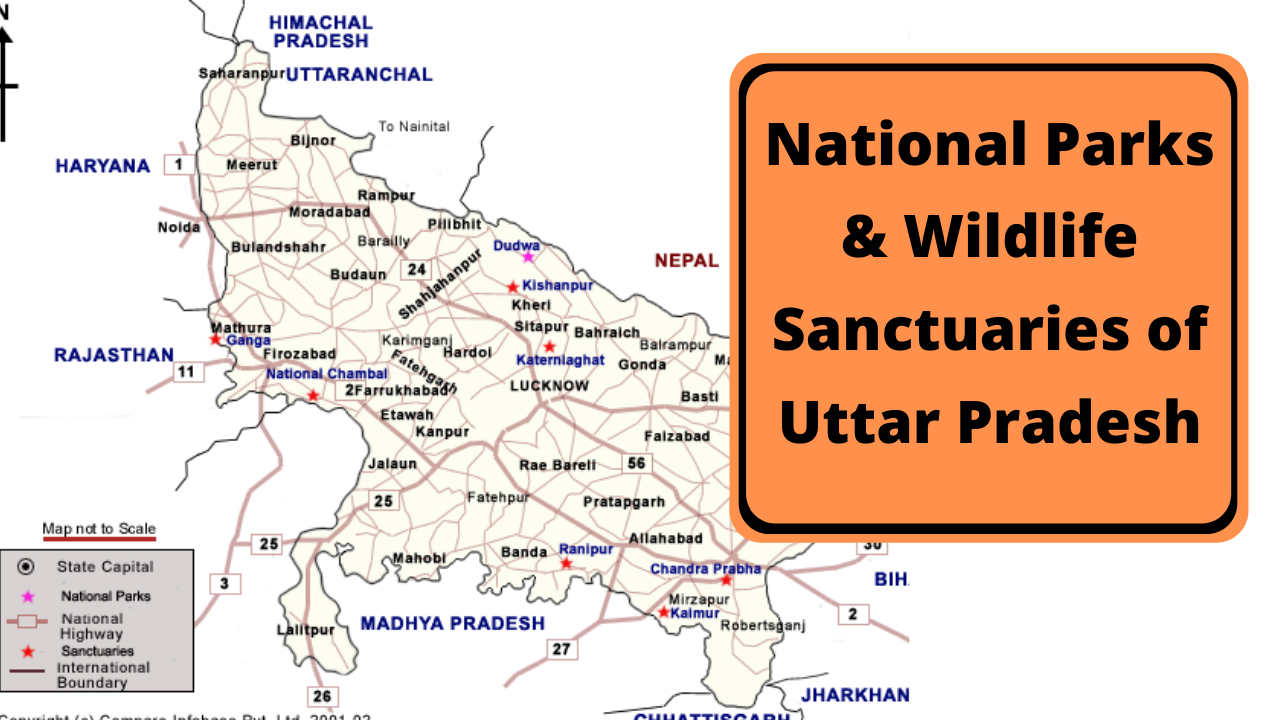
The tourism board runs along with a hashtag ‘UP nahi dekha to India nahi dekha’ which means, you have not seen India if you have not visited UP. The largest state of India has a lot to explore that ranges from pilgrimage places to wildlife sanctuaries to world class heritage sites. The world-famous Taj Mahal is in Agra district of UP. A marvelous tomb which attracts the greatest number of foreign visitors than any other heritage sites in the country.
The beauty of Uttar Pradesh lies in the emergence of cultural and religious traditions along some of the greatest rivers in the Indian sub-continent – the Ganga and the Yamuna. Throughout history, greatest cities emerge along these rivers. Exploring the state along these rivers takes the travelers a magical venture. The famous heritage arc signifies heritage in terms of cultural, historical, and natural aspects. This arc covers 3 major cities of UP, that are Agra, Lucknow and Varanasi covering most of the heritage sites and glorious tourist spots.
Wildlife and sanctuaries in Uttar Pradesh
The biggest state of India is diversified with a variety of geographical features. The state is covered with a large area of forests which is home to a huge number of wildlife species. Here are the famous national parks and wildlife sanctuaries-
Below is the complete list of all wildlife sanctuaries & national parks including bird sanctuaries, forest reserves of Uttar Pradesh, India
- Dudhwa National Park (Tiger Reserve)
- Bakhira Wildlife Sanctuary
- Chandraprabha Wildlife Sanctuary
- Dr. Bhimrao Ambedkar Bird Wildlife Sanctuary
- Hastinapur Wildlife Sanctuary
- Katerniaghat Wildlife Sanctuary
- Kishanpur Wildlife Sanctuary
- Lakh Bahosi Bird Wildlife Sanctuary
- Mahavir Swami Wildlife Sanctuary
- National Chambal Wildlife Sanctuary – UP
- Nawabganj Bird Sanctuary
- Okhla Bird Wildlife Sanctuary
- Parvati Aranga Bird Wildlife Sanctuary
- Patna Wildlife (Pundhir Bird) Sanctuary
- Ranipur Wildlife Sanctuary
- Saman Bird Wildlife Sanctuary
- Samaspur Wildlife (Bird) Sanctuary
- Sandi Bird Wildlife Sanctuary
- Sohagi Barwa Wildlife Sanctuary
- Sohelwa (Suhelwa/Soheldeo) Wildlife Sanctuary
- Sur (Soor) Sarovar (Bird) Wildlife Sanctuary
- Jai Prakash Narayan (Surha taal) Bird Wildlife Sanctuary
- Turtle (Kachhua) Wildlife Sanctuary
- Vijai Sagar Wildlife Sanctuary
Dudhwa National Park
Located in the Terai belt (lowland region of North India) of marshy grasslands, the national park is a part of Dudhwa Tiger reserve. The forest reserve is in Kheri and Lakhimpur districts.
Dudhwa National Park is home to one of the finest forests in the country. Some of the trees here are more than 150 years and over 70 feet. Major attractions in Dudhwa are tigers and swamp deer. Besides, rare species like leopard, hispid rare are spotted here. Common sightings here are sambar deer, barking deer, spotted deer, hog deer, sloth bear, ratel, jackal, civets, jungle cat, fishing cat.
Bakhira Bird Sanctuary
Established in 1980, Bakhira Bird Sanctuary is the largest natural floodplain wetland in the country. The forest reserve is named after the village named Bakhira. The water body provides a wintering and staging ground for several migratory waterfowls and a breeding ground for resident birds. Migratory birds from Tibet, China, Europe & Siberia come here from November to January which makes the best time to visit here.
Chandraprabha Wildlife Sanctuary
Chandraprabha Wildlife Sanctuary is located in Chandrauli district, roughly 70 kilometers from the city of Varanasi. Scenic waterfalls like Rajdari and Devdari attract a lot of tourists here besides there are beautiful picnic spots and dense forests.
Flora content here include alluvial savanna forest, southern dry mixed deciduous forest, dry deciduous scrub and savanna, dry tropical riverine forest, and desert thorn forest and scrub. The sanctuary lies within the Lower Gangetic Plains with moist deciduous forests.
Common wildlife sightings here are leopard, wild boar, nilgai, sambar deer, chinkara, and chital, and many species of birds.
Bhimrao Ambedkar Bird Wildlife Sanctuary
Bhimrao Ambedkar Bird Wildlife Sanctuary is located in Kunda town of Prathapgarh district. There are a lot of mammals, birds, reptiles, fishes, amphibians and invertebrates seen here. Migratory birds fly up to 5000 kms from different parts of the world to reach here.
The bird sanctuary is surrounded by the agricultural land area of Benti Uparhar, Shahpur and Lowa Sukhdevpur and Puranmau villages. The region is a part of the rich alluvial land mass of the Gangetic plains.
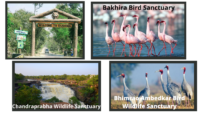
Hastinapur Wildlife Sanctuary
Spread across 2073 square kilometers in districts of Meerut, Muzzafarnagar, Ghaziabad, Bijnor, Meerut and Amroha districts, Hastinapur Wildlife Sanctuary is a protected wildlife area in the Gangetic plains of Uttar Pradesh.
Common wildlife species here include swamp deer, smooth-coated otter, Ganges river dolphin, gharial, leopard, chital, sambar deer, and nilgai. There are over 117 bird species recorded. Tall wet grasslands dominate in low-lying areas. Dry scrub grasslands dominate on elevated alluvial deposition.
Katarniaghat Wildlife Sanctuary
The Katarniaghat Wildlife Sanctuary is in Bahraich district of UP. Covering an area of over 400 square kilometers, it is a part of Project tiger and is a part of Dudhwa tiger reserve. The Katerniaghat Forest strategically connects the tiger habitats of Dudhwa and Kishanpur in India and the Bardia National Park in Nepal.
The ecosystem comprises a mosaic of sal and teak forests, lush grasslands, and wetlands. Katarniaghat is one of the best places to sight gharial and is found alongside crocodiles. It is home to a lot of endangered species like tiger, rhino, Gangetic dolphin, swamp deer, hispid hare, Bengal florican, the white-backed and long-billed vultures.
Kishanpur Wildlife Sanctuary
Founded in 1972 and covering an area of 227 square kilometers, Kishanpur Wildlife Sanctuary is a part of Dudhwa Tiger Reserve. It is near Mailani district of UP, 4.5-hour drive from Lucknow. The reserve is covered with dense forests and moist deciduous trees that include sal, teak and jamun.
Birds like he red-crested pochard, mallard, dabchick, grebe, common pochard, pintail, shoveller, river tern, the white-eyed pochard, spoonbill, egret, snakebird, heron, black-necked stork, and many other avian species frequent the tal can be spotted here. Tiger, leopard, swamp deer, hog deer, barking deer, Bengal florican, lesser florican are seen here.
Lakh Bahosi Sanctuary
Spread over 2 shallow lakes near the villages of Lakh and Bahosi in Kannauj district, Lakh Bahosi Sanctuary is a bird sanctuary. It spreads across 4 square kilometers and is home to various migratory birds from November to March.
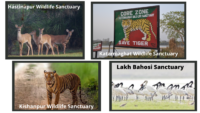
Mahavir Swami Wildlife Sanctuary
Mahavir Swami Wildlife Sanctuary spreads across 5 square kilometers and is around 125 km from Jhansi. The area is covered with dense forests and provides for a wonderful gateway to the Bundelkhand region. Common sightings here include crocodile, gharial, tortoise, python, chinkara, wolf, wild cat, hyna, wild dog, gazelle and many more.
National Chambal Wildlife Sanctuary
More popularly known as National Gharial Chambal Wildlife Sanctuary is a vast flora that spreads across 5400 square kilometers in 3 states namely Rajasthan, Madhya Pradesh, and Uttar Pradesh. The forest area is conserved to save the endangered species harial, red turtle, and Ganges river dolphin.
Located on the banks of river Chambal, the flora includes khair, palash, churel, ber and grassy patches on both sides of the river. Common mammals sighted here are rhesus macaque, langur, golden jackal, Bengal fox, common palm civet, mongoose, jungle cat, wild boar, sambar, nilgai, blackbuck, Indian gazelle, northern palm squirrel, Indian crested porcupine, hare, flying fox and Indian long-eared hedgehog.
Nawabganj Bird Sanctuary / Chandra Shekhar Azad Bird Sanctuary
Nawabganj Bird Sanctuary renamed as Chandra Shekhar Azad Bird Sanctuary in 2015 is in Unnao district on the Kanpur-Lucknow highway in Uttar Pradesh. The sanctuary provides protection for 250 species of migratory birds mostly from the soviet nations.
The sanctuary also has a deer park, watchtowers, and boats. The reptiles commonly seen here include cobra, viper, krait, rat snake and water snakes.
Okhla Bird Wildlife Sanctuary
Okhla Bird Wildlife Sanctuary spreads across 4 square kilometers in Noida. The park is situated at a point where river Yamuna enters the state of Uttar Pradesh leaving the territory of Delhi.
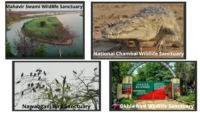
Parvati Arga Bird Sanctuary
Parvati Arga Bird Sanctuary is situated in the Gonda District of UP. It was a part of the Saryu River; however, the river changed its flow path and these lakes were left as its remains. This lake is naturally able to sustain resident birds throughout the year and migratory birds during winter season.
Parvati Arga Bird Sanctuary is part of the Upper Gangetic Plains covered with moist deciduous forests. Migratory birds during the season are greylag goose, northern pintail, cotton teal, red-crested pochard, gadwall, northern shoveler, Eurasian coot and mallard.
Patna Wildlife (Pundhir Bird) Sanctuary
Patna Wildlife Sanctuary is in Etah district of UP, encompassing a freshwater lake and is an important wintering ground for migrating birds. It is considerably the smallest wildlife sanctuary comprising just 1 square kilometer area. During peak winter in December and January,the sanctuary welcomes over 60,000 birds. Some of the winter birds who roost here include the rosy pelican, lesser Flamingo, Eurasian Spoonbill, mallard, and bar-headed goose. The common migratory bird seen here is the Northern Pintail.
Saman Bird Sanctuary
Saman Bird Sanctuary was established in 1990 and is in Mainpuri district, in western Uttar Pradesh. Spread over an area of 5 square kilometers, there are many birds which can be seen here. The place is best suited for bird safari. Besides, you can find different animals such as jackal, mongoose, hare, and various local and migratory birds.
Samaspur Wildlife Sanctuary
Samaspur Wildlife Sanctuary was established in 1987 on about 780 hectares of land. Located in Rae Bareli district, about 122 km from the capital, more than 250 species of birds can be found here. Local birds include knob-billed duck, Indian spot-billed duck, lesser whistling-duck, eurasian spoonbill, kingfishers, vultures and many more.
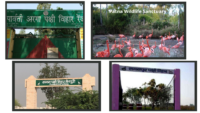
Sandi Bird sanctuary
Sandi Bird sanctuary was established in the year 1990 to protect the natural habitats and aquatic vegetation for the local residents and migratory birds. The place is home to over 200 sarus cranes. A bird interpretation center has been set up within the premises to help spread awareness about the bird life here.
Animals include fox, jackal, mongoose, porcupine and nilgai. Rare turtles include soft shelled turtle and flap shelled turtle are found here. The trees found here are babool, neem, jamun, and khajur.
Sohagi Barwa Wildlife Sanctuary
Sohagi Barwa Wildlife Sanctuary is one of the tiger habitats in Uttar Pradesh covering an area of 428 square kilometers. The sanctuary is split into seven forest ranges, namely Pakdi, Madhwaliya, Laxmipur, North Chouk, South Chouk, Seopur and Nichlaul ranges with 21 grasslands.
Tigers sighting make this place more popular and common sightings are leopard, cheetal, bear, Indian Civet, Giant Squirrel, Hare, wild cat, wild boar, Monitor Lizard, Neelgai, and Indian python.
Sohelwa Wildlife Sanctuary
One of the oldest forests in Uttar Pradesh, Sohelwa Wildlife Sanctuary was given the status of a wildlife sanctuary in 1998. The forest reserve is approximately 120 km long and 6–8 km wide, is situated at elevations of 120–202 m above sea level. It has a core area of 45,200 hectares and a buffer zone of 23,000 hectares. Common sightings here are Bengal tiger, Indian leopard, sloth bear, antelope and deer. Other animals include fox, hyena, Indian elephant, and wild cat.
Sur Sarovar Bird Sanctuary
Originally a human-made reservoir to supply water in Agra during summer. The sanctuary is also known as Keerthan lake. The entire lake is formed in an area of 7.13 square km in a pentagon shape.
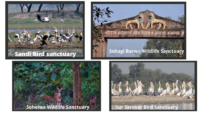
Jai Prakash Narayan Bird Wildlife Sanctuary
Alternatively known as Surha Taal Bird sanctuary by the locals, Jai Prakash Narayan Bird Wildlife Sanctuary was ceated by consolidating the land area of 45 villages of Baansdih in Ballia town area. During rainy seasons, approximately 25,000 hectares area get submerged, hence proving a natural expansion of the natural habitat.
Approximately 10,0000 birds can be sighted here. Bird migration can be seen during winter months.
Kachhua Wildlife Sanctuary
Kachua(tortoise) Wildlife sanctuary is in Varanasi district with common sightings being turtles, Gangetic dolphin, and other water animals. The sanctuary was declared in 1989 as a part of the first phase of Ganga Action Plan (GAP).
The place has its own importance to clean the water. In the Kachhua (Turtle) Sanctuary mainly soft-shelled turtles which are carnivorous species and hard-shelled herbivorous turtles – are in abundance. Rohu, bhakur, tengra, prawn, nain, bam etc. fish are also found here.
Vijai Sagar Wildlife Sanctuary
Vijai Sagar Wildlife Sanctuary was founded in 1990 located in Mahoba district. Covering an area of 262 hectares, the surrounding area of Beeja Nagar Jheel was converted to a safe, no hunting-zone. The place is home to over 200 species of local and migratory birds.
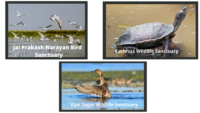
Do’s and don’ts while on safari:
Do’s
- Groom up right for the adventure
Wear light colored dress. Make sure that the cloth you wear covers the limbs. Avoid bright colors. Multi colored dress is recommended while on safari.
2. Less luggage more comfort
This is usual and better understood by the regular travelers. Carry as less luggage as possible, which holds good for any of the expeditions. Safari expeditions can be tiresome and exhausting and carrying only what is required helps ease your tension.
3. Stay calm
Making unnecessary noises would only end up inviting trouble. Stay excited but being calm and composed throughout the exploration.
4. Do not miss your camera.
Smile! You are on a camera throughout the venture. You will come across wildlife sightings that are unexpected, breathtaking, and once in a lifetime moment. Capture them with a smile.
Carry your sunglasses, hats, and sunscreen to keep yourself safe from sun rays and sunburns. Wear strong jungle shoes along with socks. Avoid footwears which expose your feet to wild nature.
5. Always have an expert guide
The naturalists are the crew who had been in and around the jungle for years. You need a high chance of sighting wildlife; it is always recommended to have them for your venture.
Don’ts:
- No littering
Ground rule – Do not carry non biodegradable materials. The forest officials in any forests are strict of this and you may end up paying hefty funds just to ruin your holiday. Cleanliness is the key.
2. No feeding to animals
This is like digging your own grave. The behavior of wild animals are predictable to no one and hence feeding them would be risky.
3. Cell Phones switched off throughout the drive
You are on a vacation and no official/unofficial calls should spoil your vacation. Long press the power button of your device and keep it aside.
4. No loud conversations
The excitement level will be at peak especially at the time of sighting. Just enjoy the moment with less or no talks.
5. No smoking or liquors
Wildlife safari is a way to connect with nature and any toxication is not at all entertained.
6. Do not over rely on properties for safari vacations.
There are a lot of licensed properties who can arrange for safari drives when you book with them. However, they do not promise. Pro-tip. Confirm your safari drives before booking the properties.
6 Benefits of booking your holiday with WildTrails
- Hassle free booking experience.
- Airport/ railway station, bus stand pick-up and drops shall be arranged.
- 24X7 support assistance from the experts.
- Expert Tiger Tracker for your safari.
- Sighting data (Exclusively from WildTrails) for effective planning of your wildlife venture.
- We take care of your complete holiday, from transfer, accommodation, safari, meals to make it stress-free.

With 4 years of Sightings data + Extensive expert tracker network in jungles, our customers had the best wildlife experiences.
Buy Wildlife Fashion Accessories
Exclusive Online Store for wildlife products
2 thoughts on “Complete List of National Parks & Wildlife Sanctuaries of Uttar Pradesh”
Comments are closed.
Packages
Packages Loading...
Recent Posts





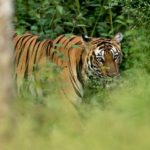




This is very helpful
very Helpfull Thank you